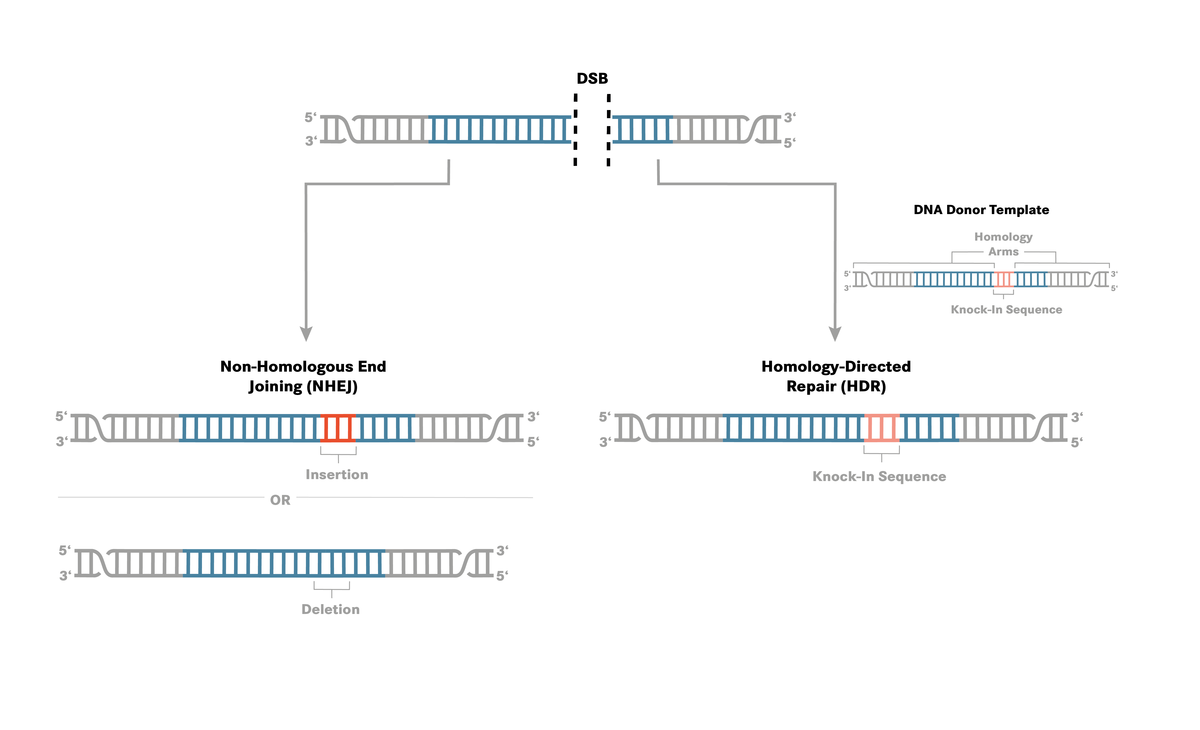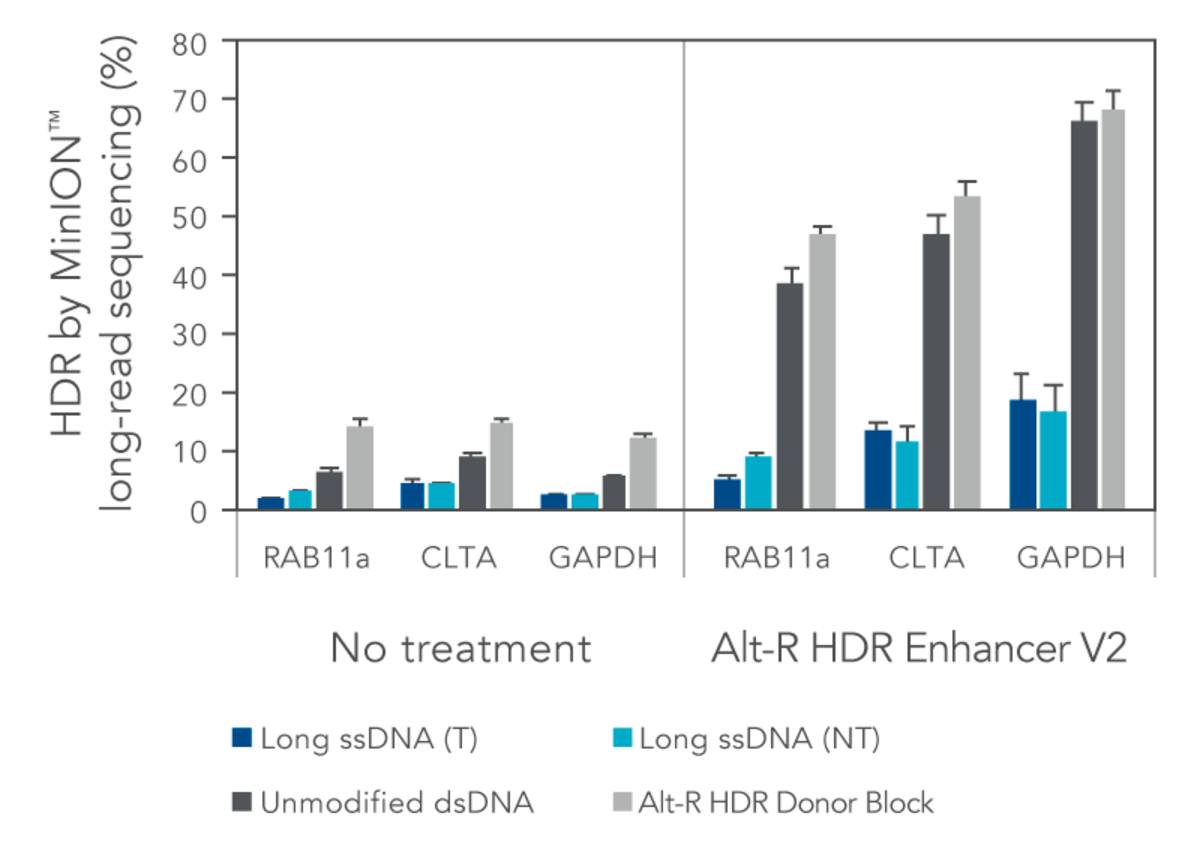Homologous directed repair (HDR)
If a DNA donor template is supplied along with the CRISPR components, knock-in of a desired sequence can be achieved via the homologous directed repair (HDR) pathway. The donor template contains the sequence of interest (knock-in sequence) flanked by sequences that are homologous to the target genomic sequence (homology arms). Because a defined template is used, HDR is typically accurate and the sequence of interest is inserted into the genome seamlessly. However, HDR only occurs in the S and G2 phases of the cell cycle and is less efficient than NHEJ. Efficiencies around 20% may be achieved but the outcome strongly depends on the cell type used.

The HDR design tool
- A complete solution for industry-leading HDR rates based on extensive wet bench testing and customer validation
- Design and order HDR donor templates and associated Cas9 guide RNAs for genome editing of human, mouse, rat, zebrafish or C. elegans targets
- Optimized donor template design and Cas9 guide RNA selection
- Flexible input and design parameters
- Outstanding HDR rates with Alt-R HDR Donor Oligos
- NEW: Alt-R HDR Donor Blocks for large knock-ins
HDR enhancer
A small molecule compound that has demonstrated an ability to increase the rate of homology-directed repair (HDR) when compared to untreated samples. The Alt-R HDR Enhancer V2 is a new and improved version that ensures efficacy at lower dosing concentrations. Use under the guidance of our updated HDR protocol here.
| Cat-No. | Enhancer | Size | Comments |
|---|---|---|---|
| 10007910 | Alt-R™ HDR Enhancer V2, 30 µL | 30 ul | HDR enhancer, provided as 0.69 mM concentrated solution in DMSO. |
| 10007921 | Alt-R™ HDR Enhancer V2, 150 µL | 100 ul | HDR enhancer, provided as 0.69 mM concentrated solution in DMSO. |
Alt-R™ HDR Donor Blocks offer an improved solution for efficient generation of large knock-ins compared to long, single-stranded DNA templates
The HDR efficiency of inserting a green fluorescent protein (GFP) tag was tested using either long, single-stranded DNA (ssDNA) or double-stranded DNA (dsDNA) templates (700 bp insert, 200 bp homology arms). The combined use of the modified Alt-R HDR Donor Blocks and the Alt-R HDR Enhancer V2 gave the higher HDR rates compared to no treatment when tested at multiple genomic loci and in multiple cell lines (Figure 1).
Figure 1. Alt-R HDR Donor Blocks offer improved large knock-in rates relative to long ssDNA HDR templates.
HEK-293 and K562 cells were electroporated with 2 µM Cas9 RNP complexes targeting three genomic loci along with 50 nM dsDNA or ssDNA donor templates by electroporation. HDR templates were designed to mediate a GFP-tagging event (700 bp insert, 200 bp homology arms). The dsDNA templates contained either no modifications (unmodified), or the Alt-R HDR Donor Block modification. Both the targeting (T) and non-targeting (NT) strands were tested for the long ssDNA templates. After electroporation, cells were plated in media with or without 1 µM Alt-R HDR Enhancer V2 with a media change after 24 hours. Genomic DNA was isolated 48 hours after electroporation. Editing was assessed by long-read amplicon sequencing on the MinION™ system (ONT) using R9.4.1 chemistry and Guppy High Accuracy (HAC) basecalling. Reads were mapped to the unedited reference amplicon or desired HDR outcome using minimap2 (-x map-ont). A read was classified to be derived from the HDR pathway if it preferentially mapped to the desired HDR outcome. HDR efficiency was measured by calculating the read counts classified as HDR relative to the total aligned reads per sample.
Documents
Take a look at our revised application note on the optimization of HDR in mammalian cell lines to explore the following:
- Criteria on selecting guide RNA sequences
- Considerations on the rational design of synthetic DNA donor templates
- Details on how to optimize every step in your experiment for more efficient HDR outcomes
For research use only. Not for use in diagnostic procedures. Unless otherwise agreed to in writing, IDT does not intend for these products to be used in clinical applications and does not warrant their fitness or suitability for any clinical diagnostic use. Purchaser is solely responsible for all decisions regarding the use of these products and any associated regulatory or legal obligations.

